Victorian Bathroom Designs: A Detailed Insight
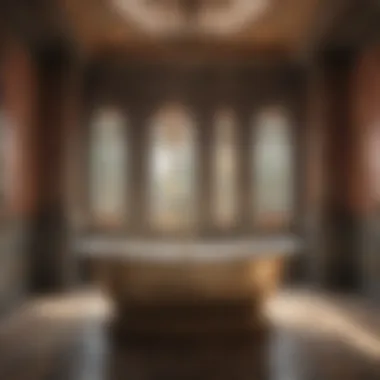
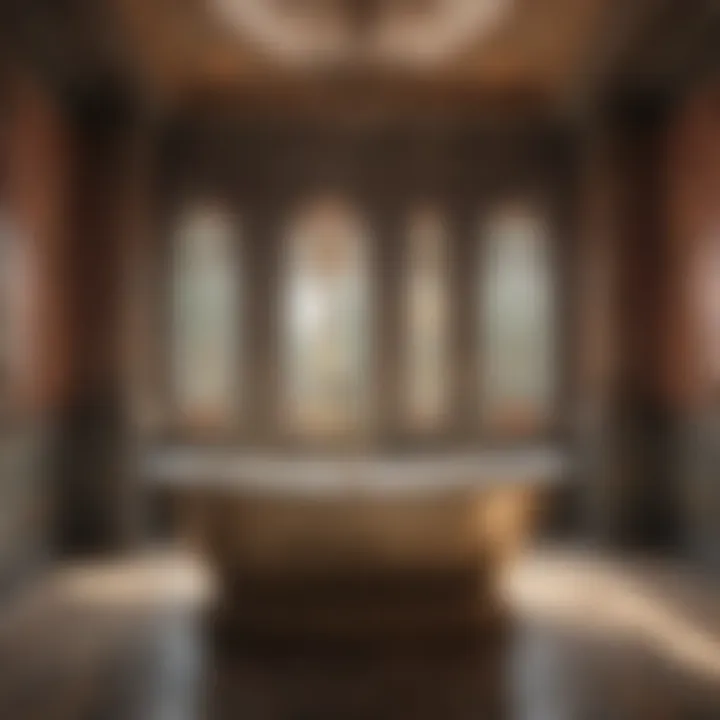
Intro
Victorian bathroom designs encapsulate a unique fusion of opulence and practicality that captures our imagination even today. Born from a time when the British Empire was at its zenith, these bathrooms embody a historical narrative mingled with aesthetic charm. To transform your bathroom into a Victorian-inspired space isn't just about adopting a style; it’s about weaving in elements of history, nuance, and emotional resonance. This exploration takes you on a journey where old-world elegance meets modern sensibilities. With the right understanding, the enchanting features of the Victorian style can be effortlessly melded with the necessities of contemporary living.
To navigate this journey, one essential aspect is to grasp current trends that influence how we integrate these classic designs into our homes. After all, understanding these influences is crucial when visualization turns into actual implementation.
Current Trends
Diving into the practical side of Victorian bathroom designs, it is clear that modern adaptations have become increasingly popular among homeowners. This interest also reflects in current trends in color palettes and popular styles.
Color Palettes
The Victorian era is known for its rich and dramatic colors. However, today’s trends tend to lean towards more muted tones that still echo the sophistication of the past. Consider these color themes:
- Deep Greens: Reflecting nature, adding a serene touch.
- Royal Blues: Evoking a sense of regal elegance, perfect for walls or accents.
- Soft Browns and Creams: For a warmer, inviting ambiance.
- Pops of Gold or Silver: As accessories or fixtures, providing that Victorian luxury vibe.
These modern adaptations allow for a balanced blend of historical charm and contemporary elegance without being overpowering.
Popular Styles
Among the many styles reminiscent of this period, a few stand out due to their adaptability:
- Heritage Style: Embracing architectural elements such as wainscoting, clawfoot tubs, and ornate fittings.
- Eclectic Mix: Combining Victorian elements with modern touches. Imagine a vintage chandelier over a sleek pedestal sink.
- Grand Millennial Design: Infusing inherited charm with contemporary functionality, making it relatable for today’s homeowners without losing its historical essence.
Each of these styles allows for personalization, ensuring the bathroom retains functional elements while echoing Victorian grandeur.
Visual Ideas
One of the most effective ways to visualize how to create a Victorian-inspired bathroom is through real-life transformations. Images can speak volumes, showcasing the practical return to a bygone era.
Gallery of Styled Bathrooms
Imagining the space can be enhanced by viewing actual styled bathrooms. Look for designs featuring:
- Harmonious blends of tiles and wallpapers with intricate patterns.
- Period-specific fixtures, like brass taps or vintage mirrors, that draw the eye.
- Thoughtfully arranged furniture that balances functionality with aesthetics.
Before-and-After Transformations
Witnessing the metamorphosis of bathrooms from modern simplicity to vintage allure spurs inspiration. Projects highlighting:
- Old, sterile spaces transformed into inviting, luxurious retreats.
- Incorporating architectural salvage from the era, such as a restored vanity.
Before-and-after scenarios often reveal the hidden potential behind classic designs, encouraging homeowners to embrace Victorian elements.
"A Victorian bathroom can serve as both a functional space and an artwork, marrying beauty and utility in every detail."
By understanding current trends and visualizing through styled ideas and transformations, modern homeowners can embrace the legacy of Victorian design. Through keen attention to color choices and integration of key stylistic elements, one can recreate the grandeur of this significant era while maintaining the comforts of modern life.
Foreword to Victorian Bathroom Designs
Victorian bathroom designs hold a unique place in the tapestry of architectural evolution. Rooted in the remarkable era of Queen Victoria's reign, these bathrooms blend functionality with opulence. The Victorian approach to bathroom design offered a radical departure from earlier utilitarian spaces, turning personal hygiene areas into sanctuaries of relaxation and style.
The significance of Victorian bathroom designs goes beyond surface aesthetics; it reflects the intricate interplay of social norms, technological advancements, and cultural values of the 19th century. Homeowners and designers today often find themselves inspired by these timeless elements, as they desire to infuse their own bathrooms with a touch of historical grandeur while maintaining practicality. This article aims to shed light on the essential components that define Victorian bathrooms and how they can be seamlessly integrated into modern homes.
In understanding this design style, one must consider elements such as ornamental fixtures, intricate tiling, and rich color palettes that characterize the era. The connection between style and usability is a thread that runs throughout the Victorian aesthetic, highlighting the importance of elegance without compromising convenience. Furthermore, as homeowners increasingly seek style cues from the past, Victorian designs offer a lens through which both beauty and function can coexist.
"The Victorian bathroom serves not merely as a utility space, but as a realm where the beauty of design harmonizes with the demands of everyday living."
As we venture into the realms of this exploration, readers can anticipate an in-depth examination of the historical context of Victorian design, the core elements that create richness, and practical tips for achieving a Victorian ambiance in contemporary settings. By bridging the past with the present, one can cultivate a bathroom that reflects individual style while honoring the grandeur of Victorian influences.
Historical Context
Understanding the historical context of Victorian bathroom designs is akin to peeking through a keyhole into a richly adorned era. The Victorian period, stretching from the early 19th century until the turn of the 20th, was marked by significant societal changes that shaped not only the homes we live in but also the ethos of design.
The Era of Victorian Elegance
The Victorian era was a time of great opulence and innovation. This period celebrated decoration, with every room in the house, including bathrooms, becoming increasingly elaborate. Mirrors weren’t just for vanity; they served to amplify light and space, drawing the eye and creating a sense of grandeur. The bathtubs were often made from cast iron and adorned with intricate patterns, resembling more of a fixture worthy of a museum than mere utility.

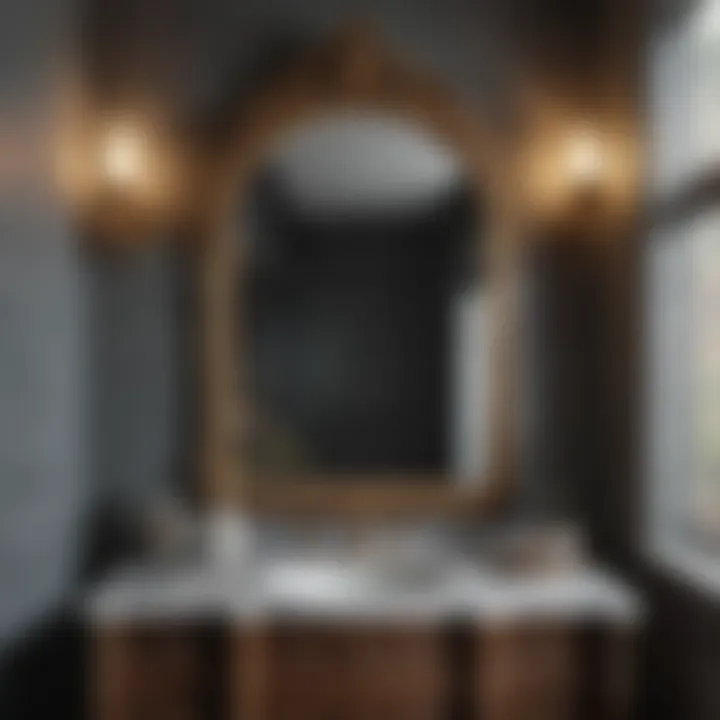
This phase in design emphasized vibrant colors and rich materials, mirroring the affluence and optimism of the time. Wood paneling, lace curtains, and ornamental tiles transformed bathrooms from simple washing spaces to sanctuaries of comfort and elegance.
Key Influences on Design
Societal Norms
During the Victorian period, societal norms were rigid and defined. People were often categorically segregated by wealth, and this impacted how spaces were designed. The burgeoning middle class began to adopt the practices of the elite, gradually becoming more invested in their homes.
One of the key characteristics of societal norms at the time was the concept of modesty intertwined with public and private lives. This duality pushed the design of bathrooms to be luxurious yet private. Unique features such as ornate screens and lavish bath linens became important elements, allowing one to enjoy indulgence without compromising decorum. This shift emphasized the bathroom not only as a space for hygiene but as a reflection of one’s social standing.
Technological Advances
The technological revolution that coincided with the Victorian age profoundly impacted bathroom design. Innovations such as indoor plumbing and the introduction of the modern flushing toilet made hygiene more accessible.
One significant benefit of these advancements was the growing emphasis on cleanliness. With plumbing improvements, homes could have bathrooms fully equipped with reliable sanitation. However, there were drawbacks, like the initial high costs associated with installation, which kept such amenities exclusive for many.
Global Trade
Global trade played a pivotal role in defining the aesthetics of Victorian bathrooms. Imported materials became symbols of status, with tiles and sanitaryware coming from places like Italy and France.
This aspect of trade enriched design choices, introducing an array of textures and styles that were previously unavailable. High-quality ceramics and metals began to appear in toilet designs, while exotic woods and ornate glass became popular for cabinetry. Yet, the reliance on imports could sometimes create a disconnect between luxury and practicality, as obtaining specific materials could be a complicated endeavor.
"The Victorian bathroom was no longer just functional; it morphed into a luxurious retreat that echoed the splendor of its time."
Core Elements of Victorian Design
When diving into the depths of Victorian bathroom designs, it's essential to consider the core elements that define this intricate style. Not merely a trend, these elements were borne out of an era where artistry met functionality. They reflect a balance between lavishness and practicality, which hold significant advantages for homeowners looking to inject unique character into their spaces. By recognizing these core elements, one can appreciate how each contributes to creating a cohesive Victorian-inspired environment that offers both aesthetic pleasure and usable features.
Color Palettes
Deep and Rich Colors
The choice of deep and rich colors serves as the backbone of Victorian aesthetics. Think shades like burgundy, forest green, and royal blue, which evoke a sense of luxury and comfort. These colors are not just pleasing to the eye; they envelop a space, creating an intimate atmosphere. One of the key characteristics of these hues is their ability to ground a room and provide a strong contrast against lighter accents and furnishings.
Moreover, deep colors can instill a timeless quality in the bathroom, making them a popular choice among renovators looking to maintain or mimic the Victorian essence. However, these bold choices do have their disadvantages: they can sometimes make smaller spaces feel even more confined if not balanced with adequate lighting or reflective surfaces.
Pastel Accents
On the other side of the spectrum, pastel accents introduce a lively brightness to the heavier tones. Light shades of lavender, mint, and soft rose can soften a room's ambiance, allowing for a brighter, airier feel. Their primary characteristic lies in their versatility; these gentle colors can harmonize well with the deeper hues, creating a layered appearance that is both stunning and functional.
While pastel accents can brighten and modernize spaces, their unique feature may sometimes be overlooked. They might not have the same historical resonance as darker tones, but they offer an important touch of elegance and freshness to a Victorian bathroom. A disadvantage is that they might fade over time under intense lighting or require more frequent maintenance to retain their charming appeal.
Materials and Textures
Woodwork
Woodwork stands as a hallmark of Victorian design, with intricately carved moldings and well-finished cabinetry. The richness of wood brings warmth and a natural element to the bathroom, complementing the lavishness often found in Victorian decor. This characteristic makes wood an absolute darling for homeowners wishing to merge style with history.
Each piece tells its own story—whether it's oak, mahogany, or walnut, there's a texture and feel that enhances the overall design. However, wood does require regular upkeep to preserve its beauty, particularly in moisture-heavy areas like bathrooms. This maintenance can deter some; however, the splendor it adds is often deemed worth the extra effort.
Marble
Moving on, marble adds a level of sophistication to Victorian bathrooms that is hard to rival. Its striking veining and sheen can create a sense of grandeur, perfect for countertops and even flooring. The key characteristic of marble is its natural elegance—each piece is unique, much like a work of art. This makes it a beneficial choice for those looking to invest in long-lasting materials.
Despite its beauty, marble does have a few drawbacks. It can be prone to scratching and staining, requiring careful attention to preventive cleaning measures and appropriately sealing surfaces to maintain their luster. Still, it delivers a classic appeal that few materials can match.
Fabrics
Fabrics, particularly luxurious textiles, play a crucial role in establishing the comfort and warmth characteristic of Victorian spaces. Velvet, damask, and brocade add texture and depth to the décor, from window treatments to towels. The distinctive character of fabrics lies in how they can elevate the sensory experience of the room, encouraging a tactile balance with the harder materials of wood and marble.
A standout feature of fabrics is their ability to shift the mood of the room. Rich fabrics can add an element of indulgence while lighter options can contribute to a more airy feel. However, this textile love story also comes with challenges—maintaining cleanliness and managing wear over time can present inconveniences.
Sanitaryware and Fixtures
Basin and Bathtub Styles
In the realm of sanitaryware, few elements capture attention like basin and bathtub styles. Victorian designs embraced freestanding tubs, often oversized with elegant curves—think clawfoot or slipper styles. These weren't mere plumbing fixtures but meant to be seen as sculptures in a bathroom's landscape, exuding a sense of luxury and indulgence.
The unique feature of these basins lies in their craftsmanship; they often enlarge the space both physically and visually, drawing the eye and creating a focal point. While they enhance aesthetics, they also require ample space and typically command a higher price compared to standard fixtures.
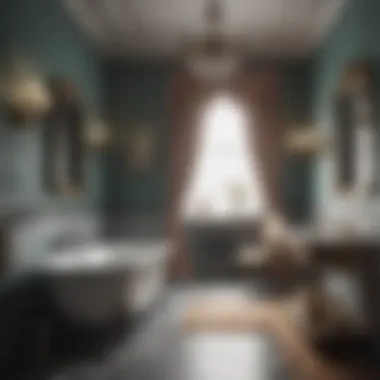
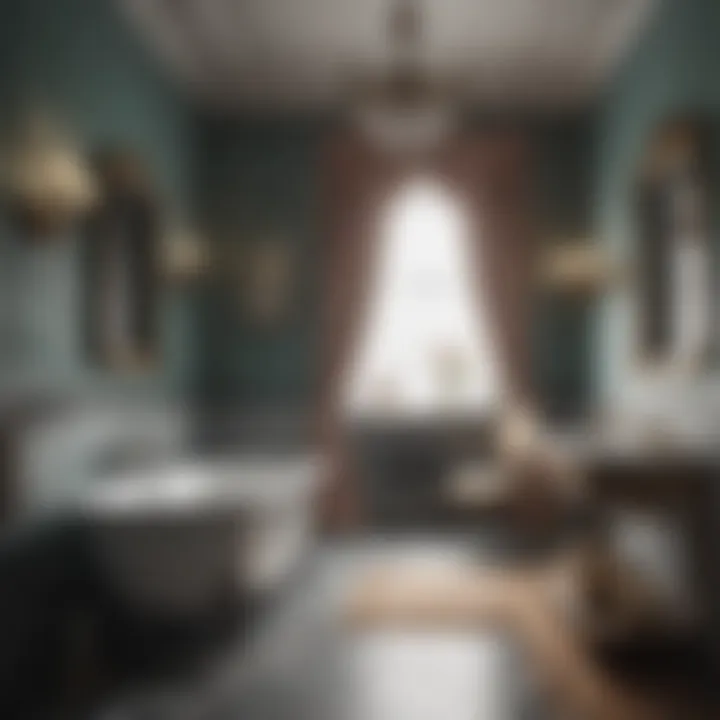
Toilet Designs
Lastly, we venture into toilet designs, which also remarkably encapsulate Victorian elegance. Early plumbing advancements made it possible to have intricately designed, high-level tanks featuring decorative chains or even art nouveau accents. The key characteristic here is the blend of form and function; they are designed not only for reliability but to contribute to the bathroom’s enchanting visual narrative.
As charming as they are, modern readers might notice that these toilet designs may not suit everyone’s taste. While novel in their day, some may find them less practical compared to contemporary counterparts, which are typically more streamlined and efficient.
In summary, understanding the core elements of Victorian design is essential for blending nostalgia with the modern bathroom experience. Each component, from color palettes to materials, offers a patchwork of historical context and contemporary practicality, allowing homeowners to appreciate the elegance and craftsmanship that defines Victorian themes.
Architectural Features
Architectural features play a crucial role in defining the character and essence of Victorian bathroom designs. These elements not only contribute to the aesthetic appeal but also enhance functionality and comfort. By understanding the distinct features typical of the Victorian era, homeowners can successfully recreate the charm and sophistication associated with that time, while merging it seamlessly into modern homes.
One of the key advantages of incorporating architectural features into a Victorian bathroom is the opportunity to create an inviting and luxurious atmosphere. Elements such as ornate moldings, high ceilings, and strategic window placements serve a dual purpose. They not only beautify the space but also affect natural light and spatial dynamics.
Ornate Moldings
Ornate moldings are a hallmark of Victorian design, adding elegance and richness to any area, most notably bathrooms. These intricate details can be found at the edges of ceilings, doors, and windows. The advantage of employing such moldings lies in their ability to elevate an otherwise simple space into something extraordinary.
Victorian moldings often feature elaborate patterns, such as floral motifs or geometric designs. They can truly bring personality into a bathroom, making the space feel more curated and intentional. When choosing moldings, consider materials like plaster or wood—both can be finished in a variety of ways to suit your desired aesthetic.
High Ceilings and Space Utilization
High ceilings are another striking feature of Victorian bathrooms. They contribute to an airy feel, making the room feel more expansive, even if it's not large by contemporary standards. In a Victorian space, you might see grandeur in such heights, with some bathtubs even placed centrally to draw the eye upward.
Utilizing the vertical space in a room comes with its own set of considerations. For instance, adding tall shelving units or decorative ladder shelving can maximize storage without making the room feel cramped. Moreover, high ceilings allow for grand light fixtures, like crystal chandeliers, potentially transforming a bathroom into a mini spa.
Windows and Natural Light
Natural light is another essential element of Victorian bathrooms. Large, strategically placed windows can dramatically change the ambiance of a space. Not only do they provide illumination during the day, but they also connect the indoor environment with the outdoor scenery. It’s an excellent way to incorporate nature within your personal sanctuary.
Consider types of windows that showcase the period’s style, such as stained glass, which can infuse colors into the space while ensuring privacy. The use of transom windows above doors can also be effective, letting more light flow into the room. Maintaining this natural light while also including decorative elements means blending form with function, allowing your bathroom to become a tranquil and stylish retreat.
"Victorian architectural features transform ordinary spaces into extraordinary experiences, reflecting a commitment to beauty and hospitality."
Modern Interpretations of Victorian Bathrooms
The evolution of Victorian bathroom designs continues to fascinate homeowners looking to capture that timeless elegance while addressing contemporary needs. In today's fast-paced world, where practicality meets aesthetic desires, modern interpretations of Victorian bathrooms provide a bridge connecting the grandeur of the past with modern sensibilities. This section delves into how blending styles and functional updates bring new life to classic designs, making them suitable for today's lifestyles.
Blending Styles
Minimalism Meets Victorian
Combining minimalism with Victorian influences might seem like a curious choice at first glance. However, this blend finds common ground in elegance and simplicity. The key aspect of this fusion lies in stripping down ornate details while still celebrating the grandeur of vintage design. Think clean lines and uncluttered spaces paired with intricate but strategically placed Victorian elements, like a clawfoot tub against a simple tiled backdrop.
This approach resonates particularly well with those who appreciate both historical charm and modern functionality. An advantage here is the ability to create a bathroom that feels spacious and airy. The contrast of sleek design alongside classic fixtures can be visually striking and serves to enhance both aesthetics and flow. However, one must tread carefully, as too much minimalism might dilute the rich character typically expected in Victorian homes. Striking the right balance is crucial.
Industrial Influences
The influence of industrial design has also made its mark on Victorian bathrooms. This hybrid approach incorporates raw materials like exposed brick, metal fixtures, and salvaged elements that play well in a Victorian setting. The key characteristic of industrial influences is its embrace of the bare and unfinished look, which can evoke nostalgia while celebrating imperfections.
The unique feature found here is the ability to showcase fixtures, such as bold faucets or light fixtures, as statements. This trend has grown popular among homeowners who seek an edgy twist on traditional styles. The advantage of this choice is its adaptability—industrial design melds gracefully with many aesthetics and can easily accommodate modern amenities. On the flip side, if not executed carefully, the strong industrial vibe may clash with the desired Victorian look, turning elegance into starkness.
Functional Updates
Water Efficiency
With water conservation becoming increasingly vital, integrating water-efficient fixtures into Victorian designs has become a necessity. The specific aspect of water efficiency involves selecting products that significantly lower water usage without sacrificing performance. This has turned into a popular choice because it aligns perfectly with both sustainability goals and the opulent styles of the Victorian era.
One standout characteristic of modern water-efficient fixtures is their technology, which ensures that every drop counts while still delivering robust performance. An advantage here is that homeowners can preserve the classic aesthetics of their spaces while being environmentally conscious. However, there might be some initial resistance to these newer products based on misconceptions about less power or performance, but many residential innovations have cleared that hurdle.
Smart Technology Integration
As technology becomes a part of daily life, smart technology integration in Victorian bathrooms presents an exciting opportunity. This modern twist means adding features like automated lighting, smart showers, and even touchless faucets. The significant aspect of integrating smart technology is the convenience offered—it can transform an ordinary bathing experience into something tailored and efficient.
People are increasingly drawn to this blend because it reflects a lifestyle that balances luxury with efficiency. A unique benefit is the ability to control ambiance manually or automatically, which can elevate the bath rituals. Detractors of this trend may argue that it detracts from the historical value of a Victorian bathroom, but thoughtful integration can highlight the space’s charm rather than overshadow it.
The balance between maintaining a Victorian feel while integrating modern features is key to avoiding a disjointed design.
By considering these modern interpretations, homeowners can create spaces that respect the elegance of the past while addressing the demands of today. Understanding how to blend styles and update functionalities not only preserves history but enriches the living experience in distinctly personal ways.
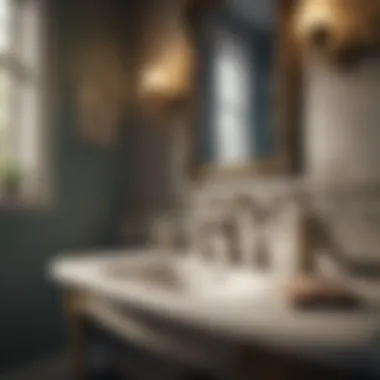

Practical Tips for Designing a Victorian Bathroom
When embarking on the journey of designing a Victorian bathroom, it's crucial to remember that this style is much more than just aesthetic appeal. It speaks to a broader narrative of elegance and sophistication that can be harmonized with modern comforts. As one delves into this comprehensive guide, it becomes apparent that specific elements and their thoughtful integration can elevate a bathroom beyond a mere functional space to a sanctuary of romance and history. Here are essential points to consider:
- Harmony and Balance: Achieving a cohesive design means balancing colors, textures, and materials. When each component complements one another, the overall space feels curated rather than chaotic.
- Practicality Meets Aesthetics: While the Victorian style is about opulence, bathrooms should remain functional. Combining beauty with usability ensures a welcoming and efficient environment.
- Attention to Detail: The little things often make the biggest difference. This could be the choice of hardware or the pattern on the wallpaper—every detail counts in bringing the Victorian allure to life.
Creating a Cohesive Aesthetic
Creating a cohesive aesthetic in a Victorian bathroom necessitates careful consideration of color schemes and textures that convey the era's luxurious feel. Warm, inviting tones such as deep reds, brocade golds, and mossy greens come to the forefront of choices, embodying the richness characteristic of the period. Mixing patterns and prints can also contribute to the overall atmosphere; however, balance is key. For instance, pairing a floral print with solid, textured materials can maintain visual interest without overwhelming the senses.
Furthermore, layering textures creates depth and warmth. Think about how velvety curtains may complement ornate woodwork or how polished brass fittings can shine against a matte backdrop. All these elements weave together to establish an environment steeped in Victorian charm.
Choosing the Right Fixtures
When it comes to fixtures, the choices should reflect the elegance of the Victorian era while still meeting modern standards. Clawfoot bathtubs are a quintessential element, offering a striking focal point that exudes luxury. Sinks adorned with intricate patterns or those fit with bold, vintage taps are equally significant; they can either revive the past or instill a dash of classic flair to the overall design.
Moreover, selecting quality vanities equipped with ornate details can drastically elevate the room. Materials like walnut or mahogany should not just feel good aesthetically but also endure the wear and tear of daily use. An emphasis on craftsmanship here lends authenticity to the Victorian aesthetic while ensuring durability and ease of maintenance.
Incorporating Accessories and Decor
Mirrors and Lighting
When aiming to enhance a Victorian bathroom's character, mirrors and lighting emerge as pivotal players in the design game. Mirrors, often framed in ornate styles—like gilded or intricately carved wood—serve dual purposes of utility and decor. Their reflective surfaces can engender an illusion of space while amplifying available light, contributing to the warm and inviting ambiance sought in Victorian spaces.
In terms of lighting, chandeliers or vintage sconces with crystal details can cast a glow that echoes the lavishness of the Victorian era. Both choices fulfill the functional requirement of illumination but as well add opulent flair to your design. However, it’s wise to ensure that the brightness is adjustable, catering to evening relaxation after a long day; too harsh lighting can spoil the charm.
Artwork and Textiles
Artwork and textiles play a critical role in instilling a sense of identity and warmth. When decorating a Victorian bathroom, consider incorporating paintings or prints that capture the spirit of the age—landscapes, florals, or depictions of domestic life can all resonate deeply with the theme.
Textiles, too, carry significance; think beyond the bath mat to richer options like lace curtains or heavily embroidered towels that can quickly elevate your space. Not only do they add a tactile layer, but visually they can anchor the various colors and patterns present in the room.
While these elements greatly enhance the overall effect, balance remains a vital factor. Too many accessories can lead to clutter, nullifying the elegance that is the hallmark of Victorian design. Selecting pieces thoughtfully, that resonate with your specific aesthetic vision, will create an inviting space that reflects both personal and historical touches.
Maintenance of Victorian Bathrooms
The maintenance of Victorian bathrooms holds substantial weight in retaining their charm and functionality. As the years slip by, it becomes crucial to address elements that reflect the historical essence while adapting to modern needs. Maintaining these spaces isn’t merely about aesthetics; it also means safeguarding investments and ensuring longevity. It can bring about several benefits that cater to both sense of style and practicality.
Recognizing the intricate designs and materials inherent to Victorian spaces can guide homeowners in making informed choices that align with both preservation and modernity.
Preserving Original Features
Original features in Victorian bathrooms—like clawfoot bathtubs, ornate sink basins, and decorative ceramic tiles—are what truly capture the essence of the time. Preserving these elements can seem daunting, yet it presents a unique opportunity to marry history with modern living.
Key steps for preserving original features:
- Regular Inspection: Schedule periodic examinations of fixtures, plumbing systems, and surfaces to detect any wear or potential issues early.
- Using Appropriate Cleaners: Avoid harsh chemicals. Instead, choose gentle cleaners that won't damage delicate surfaces or finishes.
- Protective Coatings: Applying protective waxes or sealants can help maintain the integrity and shine of surfaces without compromising authenticity.
"Keeping the spirit of the Victorian era alive demands both effort and understanding of the materials involved."
Regular Cleaning Tips
Keeping a Victorian bathroom looking fresh requires a tailored cleaning approach that respects its unique components. Regular cleaning isn’t just about looks; it ensures every nook and cranny serves its purpose without degradation.
Effective cleaning strategies include:
- Dusting and Polishing: Use soft cloths regularly to dust and polish exposed woodwork and metal fixtures to maintain their luster.
- Gentle Scrubbing: For tiles and tubs, a mix of vinegar and baking soda can be effective without causing damage; ensure you rinse thoroughly afterward.
- Check for Moisture: Inspect for signs of mold or mildew, especially around seals and joints where water tends to linger. Promptly address any issues to maintain both hygiene and aesthetics.
Being mindful about maintenance not only ensures the charm of the Victorian bathrooms is preserved but also cultivates an environment that respects the rich history embedded within these spaces.
The End: The Enduring Appeal of Victorian Designs
Victorian bathroom designs continue to resonate with homeowners and designers alike, embodying a unique blend of opulence and comfort. Their enduring appeal can be chalked up to several key characteristics that mirror both the aesthetics and values of the era. First and foremost, these designs prioritize craftsmanship; the quality of materials and meticulous attention to detail are evident in every corner. This craftsmanship is not just decorative; it signifies a time when bathing was a ritual, not merely a routine task.
A significant attraction of Victorian bathrooms is their emphasis on ornate elements. From elaborately carved wooden fixtures to intricate tile patterns, there’s a sense of grandeur that can transform any space into a personal retreat. The color palettes, often rich and deep, invoke feelings of luxury and coziness. Shades of burgundy, forest green, and navy blue, sprinkled with softer pastel accents, offer homeowners a palette that’s as versatile as it is inviting.
Additionally, incorporating Victorian elements into modern bathrooms brings a touch of nostalgia—a subtle nod to history without reeking of pastiche. By merging old-world charm with contemporary functionality, you create a space that’s both practical and steeped in character. For instance, adding vintage-inspired fixtures, which are now engineered with modern water efficiency, allows for a seamless blend of yesterday and today.
It’s also worth noting that Victorian designs reflect a balanced approach to design principles. This balance between form and function allows for spaces that are not only visually striking but also comfortable and practical for daily use. The thoughtful integration of designs, such as high ceilings that create an illusion of space, underscores this philosophy.
"Victorian design makes a statement; it says that style can coexist with comfort and efficiency."
As we move forward into more minimalist and design-conscious eras, the Victorian aesthetic offers a refreshing contrast. It invites people to explore spaces with depth and richness, providing much more than just a bathroom. Instead, these spaces become havens of relaxation, a nod to a time when craftsmanship reigned supreme.
For housewives and homeowners in pursuit of elegance, the incorporation of Victorian design is undeniably appealing. It is a reminder that in the hustle and bustle of modern life, we can still find moments of beauty and serenity. The timeless charm of Victorian bathrooms remains a touchstone for those looking to enhance their living environments. In this journey through Victorian elegance, remember that every detail enhances the story of your own home, connecting you back to an era acclaimed for its sophistication.



